|
Castor Semilooper
Scientific name: choea janata
Order : Lepidoptera
Class : Noctuidae
Distribution
- This is a serious pest of the oilseed crop and is distributed
throughout the Indian Union, wherever castor is grown.
Seasonal occurance
- It is occuring during July to September.
Life History
|
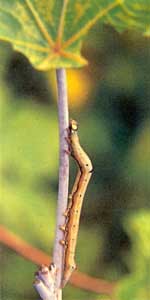
Semilooper larvae
|
- The female moth lays around 450 blue green
rounded eggs singly on the leaves of the castor
plant at night.
- The eggs are laid singly on both sides of the leaves.
- Four to six eggs have been observed on each leaf.
- The egg when freshly laid is round, pale green in
colour and measures about 0.9 mm in diameter.
- The chorion is full of ridges and furrows.
- The egg is convex on the upper surface and concave
below.
- The incubation period of the egg varies from 2 to
5 days from July to September.
- The newly hatched caterpillar is yellowish green in colour
with light brown head and thorax and measures 3.5 mm. Long.
|
- The full grown larva is dull greyish brown and measures 60
to 70 mm. Long.
- Five distinct larval instars have been observed. The larval
period lasts from 12 to 13 days in July, August and September.
- Pupation takes place either in the soil amidst the fallen
leaves or sometimes amidst the folded leaves on the plant.
The pupal period lasts from 10 to 27 days.
- A generation is completed in about 28 to 45 days.
Nature and symptoms of damage
|
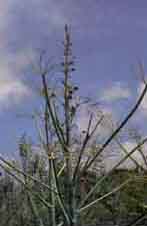
Affected castor field
|
- The smooth greyish-brown caterpillars feed on the leaves and
cause sometimes wholesale devastation of the crop.
- Damage to defoliation.
- Older larvae are voracious feeders and leave bare
stems veins
|
Control measures
Cultural control
- Hand picking of older larvae during early stages.
- Manipulate parasitic activity by avoiding chemical spray,
when 1-2 larval parasites are observed on castor plant.
Biological control
|

Larvae attacked by parasitoid
|
- A number of hymenopterous parasites attack the pest during
the various stages of its life-cycle.
- The eggs are parasitised by releasing Trichogramma
evanescens minutum @ 50000/acre.
|
- The larvae are heavily parasitised by a braconid parasite,
Microplitis Maculipennis.
- Two larval parasites, one a chalcid, Euplectrus sp. and another
a braconid Rhogas sp. have also been recorded.
Chemical control
- Spray Quinalphos 2ml or Chloropyriphos 2ml or carbaryl
(50%) 3gm or monocrotophos 1.5ml endosulphan 2ml/lit of water
if 4-5 semi-looper/plant are observed on 30 & 40 days
old seedlings.
- Spray neem seed kernal extract (NSKE) 4% synchronising with
egg early larval stage.
- Providing bird perches (10/acr) helps in reducing the incidence.
Economic threshold level
 Top
Top
Red Hairy Caterpillar
Scientific name : Amsacta albistriga.
Order : Lepidoptera
Class : Lymantriidae.
Distribution
- The pest is distributed through out the India.
Seasonal occurance
- It is active during June to August.
- The caterpillars of this pest cause serious damage to the
crop by completely defoliating the leaves during the kharif
season.
Life History
|

Egg mass
|
- The female moth lays its eggs in clusters on the under-sides
of leaves and covers them with pale brown hairs.
- The incubation period lasts from 5 to 10 days.
|
|
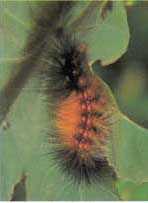
Larvae
|
- The newly hatched larvae feed gregariously and after a few days
feed on the leaves independently.
- Larva has a red head ,body covered with long dense
,reddish brown hair, anteriorly and posteriorly black
broad bands enclosed a reddish area in the middle.
|
|

Larvae burrowing for pupation
|
- The larval period varies from 15 to 85 days and the pupal period
7 to 20 days.
|
|
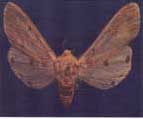
Adult moth
|
- The pest is active throughout the year and several generations
have been observed.
- The peak period of activity is August-September.
|
Nature and symptoms of damage
- Larvae defoliate the crop.
- Major damage is caused by migrating caterpillars.
- More destruction to young crop.
- When the soft foliage has been exhausted, they even turn to
the bark to satisfy their insatiate appetite.
Control measures
Cultural control
- Setting of light traps (250 watts mercury lamps) on community
basis with the first monsoon rains to attract the moths and
kill them.
- Sowing cucumber along with castor.
- Placing the twigs of Ipomoea, Jatropha
and Calotropis to attract the migrating caterpillars
and kill them mechanically.
Biological control
- One scelionid egg parasite, Aholcus euproctiscidis and
two braconid larval parasites, Apanteles enproctisiphagus
and Glyptomorpha deesae have been recorded.
- There is heavy infestation by Apanteles and every effort should
be made to conserve the parasite population in the field.
Chemical control
- Spray monocrotophos 1.6ml or fenvalerate (0.02%), Quinalphos
2ml, or Methyl Parathion (0.02%) or Dimethoate 2ml.
- Trenching around the field 2ml and dusting with endosulphan
4% or Methylparathian 2% or Quinolphos 1.5% to control migrating
larvae.
 Top
Top
Tobacco Caterpillar
Scientific name: Spodoptera litura
Order : Lepidoptera
Class : Noctuidae
Distribution
- The pest has a wide distribution throughout the Indian
Union and occurs as a sporadic pest.
Seasonal occurance
- Active during August to October.
Life History
|

Egg mass
|
- The female moth lays eggs in clusters clothed with brown hairs.
|
|

Young Larvae
|
- The incubation period of the egg varies from 3 to 5 days.
- The newly hatched larvae are blackish-green in colour
and feed gregariously for a short period before dispersal.
|
|

Grown up larvae
|
- The full-fed larva is velvety-black in colour and measures 35 to
40 mm. long.
- They behave like cutworms as they grow and sometimes cause
extensive damage to the plants at night. In view of this behaviour
the pest is classified as a cutworm.
|
- The larval period varies from 15 to 30 days.
- Pupation takes place in the soil and the pupal period varies
from 7 to 15 days.
- Eight generations have been known to be completed during a
year.
Nature and symptoms of damage
|
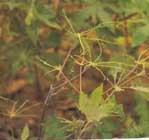
Skeletonised leaves
|
- The early instar larvae feed gregariously on the under surface
of the leaf leading to skeletonization of the leaves.
- Later they disperse, become solitary and nocturnal.
They also feed on the flower buds, flowers.
|
Control measures
Cultural control
- If the area to be treated is small, collect and destroy
the egg masses and caterpillars in the early stages of infestation.
- Plough up the soil so as to expose the pupae to predators
and parasites.
- Monitoring the pest with pheromone traps (4-5/acr) helps in
timing of treatment.
Biological control
- A large number of parasites have been recorded.
One ichneumonid larval parasite, Angitia argenteopilosa has
been recorded.
- The braconid parasites, one larval and another egg-larval,
Apanteles prodeniae and Chelonus sp. have also been recorded.
- The pupae have been found to be parasitised by an eulophid,
Trichospilus pupivora.
Chemical control
- To control early stage larvae, spray neem seed kernel
extract (NSKE) 4% or Spray Chloropyrifos 2.5ml or monocrotophos
2ml or Quinolphos 2ml or neem oil 5ml in one lit of water.
- As the grownup larvae move down to soil to hide during day
time, poison bait (1litre of monocrotophos or 1kg Carbaryl
in 10kg of bran, 1kg jaggery, little water to make the bait
in to pellets for one hectare) placement at base of the plant
helps in killing the larvae.
Economic threshold level
 Top
Top
Jassids
Scientific name :
Empoasca flavescens
Order :
Homoptera
Distribution
- The castor jassid occurs on castor as a minor pest.
- It has been recorded from Bihar, Madras and Assam.
- Outside India it has been recorded in Burma.
- Besides castor it infests tea.
Seasonal occurance
- Peak infestation of jassid is during November to January.
- Mostly seen at seedling stage, some times found almost throughout
the year.
Life History
|
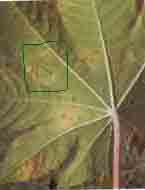
Jassid Nymph
|
- Adults are greenish yellow, wedge shaped with a pair of black
spots on vertex and a black spot on each of the forewings.
- Female inserts eggs into leaf veins on the underside.
- Eggs hatch in 6-10 days and nymphal period is 7-9
days.
- Nymphs are pale greenish almost translucent and walk
diagonally.
- Completes 7-8 generations in a year.
|
Nature and symptoms of damage
|
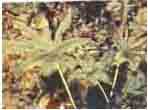
Curling of leaves due to jassid
attack |
- Nymphs and adults suck sap usually from the under surface of
the leaves and inject toxin causing curling of leaf
edges and leaves turn red or brown. The leaves dry
up and shed.
|
Economic threshold level
Control measures
Chemical control
- Spraying with any systemic insecticide.
- Seed treatment with imidacloprid or carbosulfan or stem application
with monocrotophos protects the crop from all sucking pests
including Jassids for about a month.
- Spray monocrotophos (0.05%) or dimethoate (0.05%). Repeat
spray if required after a fortnight.
 Top
Top
Gram caterpillar :Helicoverpa armigera
|

Gram caterpillar
|
- It is a polyphagous pest.
- It infests castor as defoliator.
- Moths are medium sized, stout, pale-brownish yellow
with reddish brown tinge.
|
- Forewings are olive green to pale brown with a pale brown
circular spot in the centre and double waved lines close to
outer margin.
- Hind wings are pale smoky-white with a broad blackish outer
border with dark broken grey lines and dark and pale bands
feeds voraciously on leaves.
- The creamy eggs are laid singly preferably on young leaves.
- Pupation takes place in the soil.
Control
- Spray endosulfan, chlorpyriphos, quinalphos, @ 2ml/litre
of water and fenvalerate, cypermethrin @ 1ml/litre of water.
NPV may also be sprayed @ 250 LE/ha.
 Top
Top
Bihar Hairy Caterpillar : Spilosoma obliqua
|
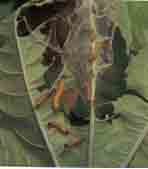
Larva of Bihar hairy caterpillar
|
- This pest occurs during October to December and of late it is
also occuring from July.
- In recent years, it has become an important pest on
groundnut also.
- Adult moth is reddish brown with black spots.
- Both the wings are pinkish and posses black spots.
|
|
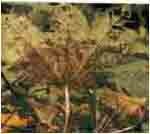
Affected leaf
|
- Female lays eggs in masses on leaves.
- The larvae are pale yellow coloured with yellow hair
over the body.
- They are polyphagous, feed on leaves and cause loss
by way of defoliation.
- In severe cases only stems are left behind.
- In defoliated crops it also feeds on capsules.
- Pupates in leaf litter close to the plants. There
are several generation per year.
|
Control
- Collection and destruction of eggs and early stage larvae
helps in arresting the multiplication of population.
- Spray NSKE 4% to kill early stage larvae.
- If grownup larvae are seen, spray endosulfan, monocrotophos,
quinalphos, or chlorpyriphos@ 2ml/litre of water.
 Top
Top
Castor Slug
Scientific name : Latoia lepida
Order : Lepidoptera
Class : Limacodidae
Distribution
- It is most common in the southern regions of the country
especially Madras and has been recorded from Ceylon also.
Seasonal occurance
- This pest damages the castor plant sporadically.
Life History
|
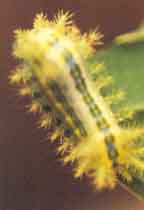
Slug Caterpillar
|
- The female moth lays flat scaly eggs on the tender parts of the
plant in small clusters.
- The full-grown caterpillar measures 15-25 mm in length.
- Thick short spiny hairs out of rows of warts on the
body.
- It is bright green in colour and has interrupted blue
stripes on the dorsum.
- It moves like a slug.
- Pupation takes place in a hard greyish cocoon on castor
stem or the trunks of its other host plants.
- The pupal period lasts from three to five weeks or
longer.
|
Nature and symptoms of damage
- The caterpillars are spiny and when touched, cause irritation
to the skin.
- To begin with, they feed gregariously on the leaves of castor
and later spread over to the entire plant.
Control measures
- The pest should be kept in check by picking the gregarious
caterpillars and the cocoons which are found in numbers on
tree trunks and destroying them in water with a film of kerosene.
- Spray chloropyriphos 2ml or Endosulphan 2ml or methyl parathion
1ml per litre of water if pest attack is more.
 Top
Top
Capsule Borer
Scientific name : Dichocrosis punctiferalis
Order : Lepidoptera
Class : Pyralidae
Distribution
- The pest is distributed throughout the plains and the
hills of the Indian Union.
Seasonal occurance
- Infestation starts from flowering stage. Usually active
during Nov. - March
Life History

|
- The female moths lay eggs on the tender parts of the plant.
- The caterpillar that hatches out bores into the shoot
if the plant is young and knit the seed capsules if
the plant is old.
|
- The full-grown caterpillar is stout, reddish brown in
colour and measures 15 to 25 mm. long. It pupates in a silken
cocoon.
Nature and symptoms of damage
|
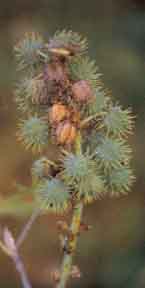
Affected Shoot
|
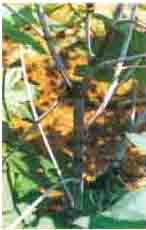
Forming of web by larvae
|
- The caterpillars bore into shoot and seed capsules and cause extensive
damage to the crop and characteristic webbing of capsules
alongwith excreta is seen.
|
Control measures
Mechanical control
- The infested shoots and seed capsules may be collected
and destroyed.
Chemical control
- Spray monocrotophos 1.6ml or Dimethiate 2ml or Quinolphos
2ml or Endosulphan 2ml or dust the spike with quinalphos (1.5%)
or methylparathion (2%).
- Spraying can be done at flowering and 15-20 days later.
 Top
Top
Whitefly
Scientific name : Trialeurodes ricini
Order : Homoptera
Class : Aleurodidae
Distribution
- The castor white-fly is a pest of castor in some regions
of our country.
- It is more commonly found in Bihar, Maharashtra, AndhraPradesh,
Telangana and Tamilnadu.
- Sometimes the damage caused by this pest to castor crop is
serious.
Seasonal occurance
- More serious in summer months(March to May).
- Temperature of 30°C with high relative humidity favours
multiplication of the pest.
Life History
|
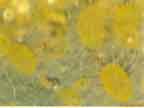
Whitefly nymphs
|
- The adult fly has white wings, yellow body and pale white legs
and antennae.
- It is a tiny insect a little less than a millimeter
in length.
- The female lays shining white long eggs in small clusters
or scattered about on the underside of tender leaves.
- The eggs hatch into nymphs which settle on the leaves
and along with the adults suck the sap from the leaves.
|
- This makes the leaves appear sickly.
- Both the nymphs and the pupa are yellowish in colour.
Nature and symptoms of damage
|
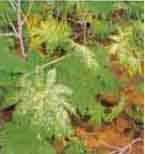
Infested leaf
|
- Both nymphs and adults suck sap from leaves.
- This makes the leaves appear sickly and sooty mould
is developed a white fly infestation is severe.
|
Control measures
Biological control
- Predaceous spiders, coccinellid larvae and adults feed
on the pest and a chalcid parasite parasitises the puparia.
- These should be conserved to keep the incidence of the pest
in check.
Chemical control
- The damage of white flies may be kept down by spraying
the infested plants with 0.05% malathion or monocrotophos
(0.05%) chloropyrifos (0.05%).
- Early stages neem oil 5ml/lit can be spray on the under surface
of the leaf. Stem applications with monocrotophos and seed
treatment with Imidacloprid 5gm/kg seed may be done for control.
Economic threshold level
- 8-10 adults/leaf or 20 nymphs/leaf.
 Top
Top
Thrips : Retithrips syriacus
|
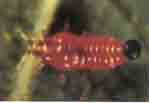
Nymph
|
- Very tiny pinkish nymphs and black adults with fringed wings
feed both on the upper and lower surfaces of the leaves.
|
|
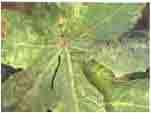
Affected leaf
|
- The terminal leaves crinkle and appear silvery.
- If infestation is severe, stunted growth rusults.
|
Control
- Under severe infestation spray monocrotophos or phosalone
or acephate or Dimethoate @ 1.5 ml/liter of water to cover
thoroughly both the upper and lower surfaces of the leaves.
- Same control measures for whitefly can be adopted for thrips
also.
 Top
Top
Serpentine leaf miner : Liriomyza trifolii
|
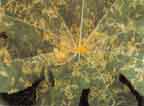
Mined leaf
|
- The minute orange yellowish, apodous larva tunnels the epidermis
of leaves making serpentine mines.
- It is an introduced polyphagous pest occurring on
castor, gourds, melons, tomato and leafy vegetables.
- On castor the incidence is seen from August to October.
|
-
Drying and dropping of leaves under severe conditions
can be seen.
- Spray neem seed kernal extract (NSKE) 4% or triazophos @ 2.5ml/litre
of water.
 Top
Top
|
